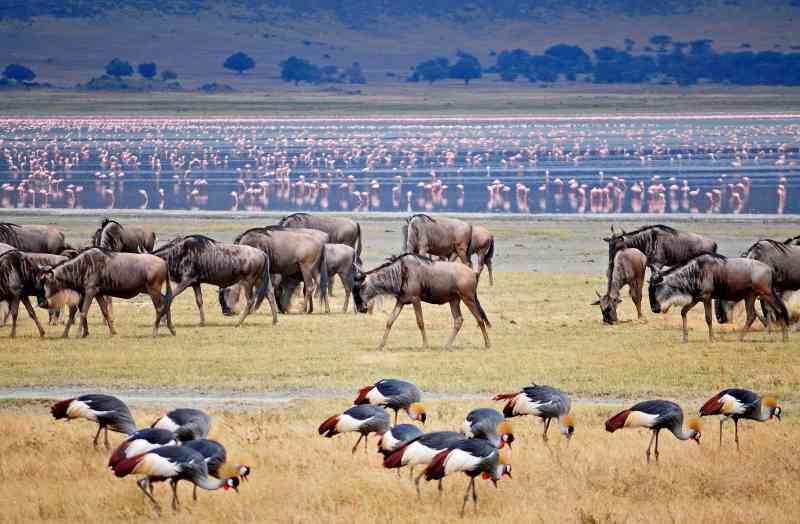Day 1: Arusha to Tarangire National Park – Tanzania
Your affordable African Safari Tanzania begins with an early morning briefing in Arusha before heading to Tarangire National Park, a lesser-known gem renowned for its vast elephant herds, iconic baobab trees, and dense wildlife population. During the dry season, the park comes alive as thousands of animals, including elephants, buffalo, giraffes, wildebeest, and the rare oryx, migrate to the Tarangire River, followed closely by predators like lions and leopards. With over 550 bird species and stunning landscapes, Tarangire offers an exceptional game-viewing experience, perfect for capturing unforgettable memories during your full-day safari with a picnic lunch.
- Included Activity: Tarangire Safari Game Drive
- Meals Included: Picnic Lunch, Dinner
- Accommodation: Tarangire Ndovu Tented Lodge (or similar)
About Tarangire Ndovu Tented Lodge
Tarangire Ndovu Tented Lodge lies in the heart of Tarangire National Park and offers a luxurious yet authentic safari experience. Ten spacious suites and two inter-connected family suites feature polished concrete floors, netted windows with roll-up canvas for ventilation, and double sliding doors with mosquito netting and great views over the plains. Enjoy wholesome meals in the thatched dining area or by the swimming pool, and unwind with sundowners around the campfire. The lodge is powered by solar and generator energy and there is free Wi-Fi. Activities include game drives, guided walking safaris, bush breakfasts, and cultural visits for a well-rounded Tanzania safari adventure.
Day 2: Tarangire National Park – Tanzania
Day 2 of your affordable Tanzania Safari is devoted to exploring the Tarangire National Park. The Tarangire River is a critical lifeline that draws wildlife to its banks, particularly during the dry season in Tanzania. Surrounding the river are expansive savannahs dotted with iconic baobab and acacia trees, creating a quintessential African landscape.
Criss-cross the landscape in search of the diverse wildlife that crosses your path. The south and west of the park transition into swampy floodplains and seasonal wetlands, while the eastern regions feature rolling hills interspersed with patches of dense woodland and rocky outcrops.
As the light begins to fade, return to the lodge for a hearty dinner and relax by the campfire.
- Included Activity: Full-Day Tarangire Safari Game Drive
- Meals Included: Breakfast, Lunch & Dinner
- Accommodation: Tarangire Ndovu Tented Lodge (or similar)
Day 3: Tarangire to Lake Manyara & Karatu Highlands – Tanzania
Enjoy a final morning game drive in Tarangire National Park. We are then back on the road, headed to the highlands of Karatu, nestled between Lake Manyara and the Ngorongoro Conservation Area. The highlands are known for their lush, fertile landscapes and cool climate, ideal for agriculture and coffee farming. This picturesque region features rolling hills, vibrant green plantations, and charming rural villages, serving as a serene gateway to Tanzania’s iconic northern safari circuit.
En route, we stop to visit Lake Manyara National Park, known for its tree-climbing lions and breathtaking scenery. The soda-ash Lake Manyara lies at its centre, attracting hosts of flamingos. We overnight in the Karatu highlands bordering the Ngorongoro Conservation Area.
- Included Activity: Morning Tarangire Safari Game Drive
- Meals: Breakfast, Lunch & DInner
- Accommodation: The Retreat at Ngorongoro (or similar)
About The Retreat at Ngorongoro Crater
The Retreat at Ngorongoro, located in Karatu near the Ngorongoro Conservation Area, is an eco-friendly lodge set amidst a lush landscape resulting from the planting of over 40,000 indigenous trees. This initiative has created a haven for birdlife, insects, and small animals, while the lodge produces its own honey, coffee, jams, juices, and fresh food from its vegetable garden and orchard. The 25 spacious cottages, each with a 90-square-meter interior and a deck overlooking the Ngorongoro forest, provide a luxurious retreat. Guests can enjoy farm-to-table dining at Kipepeo Restaurant, relax in The Nest Lounge, swim in the tranquil pool, or stay active in the fitness room, all while embracing the lodge’s serene and sustainable ethos.
Day 4: Karatu to Ngorongoro Crater & Serengeti National Park – Tanzania
Start your day early for a full morning and picnic lunch in the awe-inspiring Ngorongoro Crater, a true natural wonder. Descend the steep sides of this volcanic caldera for exceptional game viewing, with a high chance of spotting four of the Big Five of Africa alongside a diverse array of bird species, all framed by the lush, forested crater walls. The crater’s varied terrains, including forests, grasslands, and both freshwater and soda lakes, create a breathtaking backdrop for one of nature’s most extraordinary spectacles.
(Note, depending on the timing of your tour, the crater visit may take place in the afternoon on Day 3 of your Tanzania Safari. The timing of this activity will be confirmed by your guide when commencing this safari.)
Next, our African Safari Tanzania heads to the Serengeti National Park, a vast expanse that is home to over three million large mammals and plays host to the iconic annual wildebeest migration. This natural spectacle sees over a million wildebeest trekking in search of grazing, accompanied by predators and other wildlife. From January to March, the herds gather in the southern Ndutu area for calving, before moving north through the central Serengeti and Western Corridor by June and July. August to October brings dramatic river crossings at the Mara River, into Kenya’s Masai Mara. The return south comes around November to repeat this instinctive cycle that happens year after year.
Enjoy a three-night stay in the Serengeti to witness this remarkable event. We have three seasonal safari camps, ideally positioned to witness the different phases of the great migration. Depending on the timing of your visit, you will stay at one or two of these camps, depending on the season.
From December to February, you will overnight at Ndutu Camp in the southern Ndutu area of the Serengeti ecosystem. At this stage of the Great Migration, the herds are drawn to the grass plains and lakes and you will witness the birth season of thousands of wildebeest.
Between March and October, we make our way to the central Serengeti, a pivotal stop for the Great Migration, with wildebeest and zebras passing through twice yearly between April and June, and again from October to November. The central Seronera region is also considered the “big cat capital” of Serengeti National Park, known for some of the highest predator concentrations in the Serengeti.
- Included Activity: Ngorongoro Crater Safari
- Meals: Breakfast, Lunch & Dinner
- Accommodation: Ndutu Camp (December – February), Central Camp (March – October)
About Ndutu Camp
Ndutu Camp is a charming seasonal tented camp situated in the southern Ndutu area of the Serengeti ecosystem It is open from December to March to align with the spectacular wildebeest calving season. Set under shady acacia trees on a private site, the camp offers an intimate safari experience with ten well-spaced tents, including a 4-bed family tent. Each tent features en-suite facilities and solar-powered lighting. The Ndutu area’s short-grass plains and seasonal lakes draw the Great Migration during this time, making it an unparalleled destination for witnessing the birth of thousands of wildebeest, along with an abundance of predators on the prowl and diverse birdlife. The area also features some unique ecosystems ranging from soda lakes to woodlands.
Ndutu Camp offers warm hospitality and delicious, homely meals—often served al fresco beneath the starlit African skies. Unwind in the central lounge and bar area, share stories around the campfire, or simply revel in the tranquil ambience. All meals and local drinks are included. Whether arriving by road from Arusha or flying into the nearby Ndutu airstrip, Ndutu Camp provides a perfect base for experiencing the magic of the Serengeti during its most dynamic season.
About Serengeti Central Camp
Serengeti Central Camp is a luxurious yet intimate safari camp in the heart of the Serengeti, east of the famous Seronera region. The area is a pivotal stop for the Great Migration, with wildebeest and zebras passing through twice yearly between April and June, and again from October to November. The Seronera region is considered the “big cat capital” of the Serengeti, known for some of the highest predator concentrations in the Serengeti. It features a mix of open savannahs, acacia woodlands, and the Seronera River, providing an excellent year-round water source. The camp offers exceptional year-round game viewing, including sightings of lions, leopards, cheetahs, and the resident herds of grazers.
Central Camp features just ten spacious safari tents, including a family tent. Each tent is en suite with flushing toilets and bush showers, complemented by a private verandah for relaxation. Enjoy gourmet meals in the central dining tent, unwind in the cosy lounge tent with a small library and games, and savour sundowners around the evening campfire. All meals and local drinks are included. Central Camp offers optional balloon safaris, bush breakfasts, and fly-in packages for those seeking a seamless African adventure. The camp’s prime location allows easy access to the Seronera airstrip, just a 30-minute drive away.
Day 5 & 6: Serengeti National Park – Tanzania
The next two days of your African Safari Tanzania are devoted to exploring the great Serengeti and its incredible wildlife. Embark on game drives that crisscross the park in search of the animals on their great migration, and the predators who follow along to take advantage of the vast numbers of available prey. Depending on the season, you will overnight at a camp that takes full advantage of the location of the Great Migration at this time.
From December to February, we remain in the Ndutu region and marvel at this time of regeneration when the great herds produce their babies on these fertile plains. And where the herds gather, the predators are not far behind. The abundance of prey is a magnet for hungry lions, leopards, and cheetahs. The birdlife around the lakes is also magnificent.
From March to June, we remain in the central region, seeking out the grazers and the huge numbers of big cats that make the Seronera region renowned. From July to October the Great Migration is moving north in Tanzania and we make our way to North Camp. This location is prime for witnessing the vast herds of wildebeest and zebras cross the crocodile-infested waters of the Mara River.
You may wish to embark on an optional Hot Air Balloon Safari over Serengeti, one of Africa’s most iconic and breathtaking national parks. It is sure to be an experience beyond words. Imagine the serene stillness as you glide over the plains, with the awe-inspiring view of the sprawling wilderness, full of wildlife, below as you gaze over the basket’s edge. The adventure begins at dawn and concludes with a delightful champagne bush breakfast, making it an unforgettable must-do African experience.
- Included Activity: Serengeti Safari Game Drives
- Optional Activity: Hot Air Balloon Trip
- Meals: Breakfast, Lunch & Dinner x2
- Accommodation: Ndutu Camp (December – February), Central Camp (March – June), North Camp (July – October)
About Serengeti North Camp
Serengeti North Camp is a seasonal safari camp in the northern Kogatende area of the Serengeti, near the famed Mara River. This location is prime for witnessing the vast herds of wildebeest and zebras cross the crocodile-infested waters of the Mara River between July and October on the Great Migration. Set amidst beautiful rolling hills, open plains, and lush riverine woodlands, the camp provides an unparalleled wildlife experience.
North Camp offers ten spacious tents, including a 4-bed family tent, with comfortable beds, en suite facilities and a private verandah for relaxation. Powered by solar energy, the camp provides modern comforts like a central dining tent, a lounge with a small library, and a recharging station for electronic devices. All meals and local drinks are included. Its proximity to the Kogatende airstrip ensures convenience for fly-in safaris, making it an excellent choice for travellers seeking adventure and seclusion.
Day 7: Serengeti to Arusha – Tanzania
After breakfast, it is time to say farewell to the camp staff and this breathtaking wilderness. Make the journey back to Arusha by road, a 6 to 8-hour journey depending on your camp location and the game viewing along the way.
For those staying at North Camp in Northern Serengeti, a return flight to Arusha is required (and included in the tour price), due to the impracticality of covering the distance by road in a single day. For those staying at Ndutu Camp or Central Camp, you may opt for a scenic flight back to Arusha or Kilimanjaro Airport instead of the road transfer (optional extra). The flight offers breathtaking views of the Rift Valley escarpments and Ngorongoro highlands. Your well-priced African Safari Tanzania comes to an end on your arrival in Arusha.
- Meals Included: Breakfast
Tanzania Safari Notes
All Tours are conducted on a scheduled departure basis. A minimum of 2 clients is needed to guarantee a departure.
African Safari Tanzania Accommodation
Serengeti Camps may vary slightly depending on the time of year of your visit in order to give you the best possible game-viewing experience. Please note that on rare occasions changes from this itinerary may need to be implemented. Your final itinerary will be confirmed at the time of booking.
The accommodation listed in this itinerary is subject to availability. Should the listed establishment not be available, a similar lodge of the same standard will be booked. This will be conveyed to you at the time of booking.
Talk to one of our travel experts if you would like us to arrange accommodation before and/or after your Tanzania Safari Tour
For more details contact African Budget Safaris
Wildebeest Great Migration Explained
Please note that the Wildebeest Great Migration is seasonal. As a natural wildlife phenomenon, it is fluid and unpredictable. For this reason, seeing the Great Migration cannot be guaranteed.
The wildebeest and other wild herbivores migrate between Masai Mara in Kenya and Serengeti in Tanzania. These herds move in a massive circular route covering some 1,200 miles (1,931km). It is a continuous movement of wildlife that can be seen in different areas at different times of the year.
During certain phases of this annual trek, the animals disperse or slow down, whilst at other times the migration picks up speed, with the herds becoming larger and denser. Not only does the Wildebeest Great Migration vary from place to place and season to season but the movement of these large wildlife herds varies from year to year.
Please talk to a travel expert at African Budget Safaris about seeing the Great Migration on your East African safari to find out more. Also, check out our detailed article about the Great Migration in Serengeti and Masai Mara.












